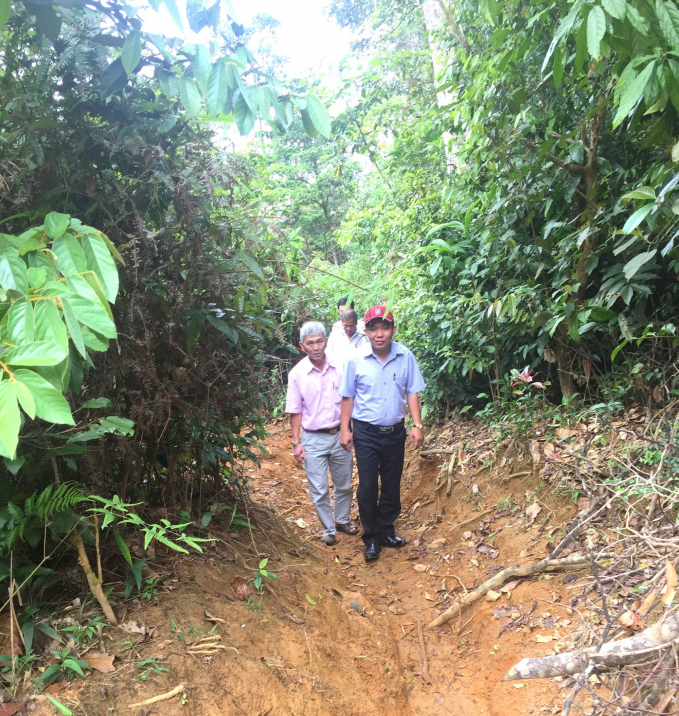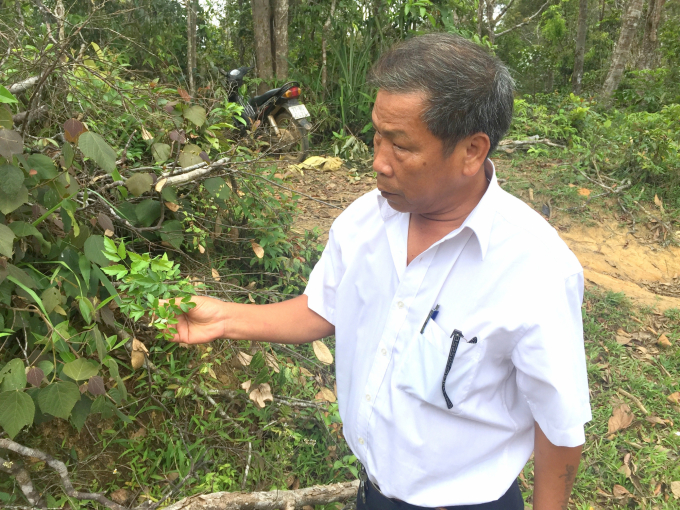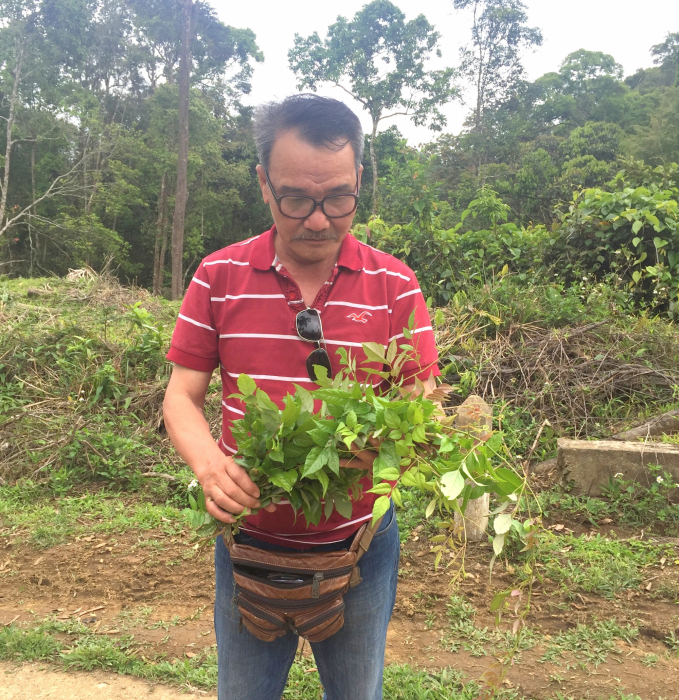June 20, 2025 | 02:25 GMT +7
June 20, 2025 | 02:25 GMT +7
Hotline: 0913.378.918
June 20, 2025 | 02:25 GMT +7
Hotline: 0913.378.918
With a natural area of about 22,450 ha, An Toan Nature Reserve is located entirely within An Toan commune. This is an area with very high natural forest coverage, more than 88%. In which, more than 52% are the primary forest area that still retains nature’s standard samples.
An Toan Nature Reserve’s flora and fauna possess high biodiversity. There are 547 species of high-tier plants belonging to 304 genera and 110 families; 300 animal species belonging to 89 families and 28 orders of the four classes of mammals, birds, reptiles and amphibians. In particular, 10 species of plants, 72 species of rare and endangered animals are listed in the Red Book of Vietnam; along with 4 species of plants and 14 species of animals categorized as “endemic” in existence.
There are also many indigenous medicinal plants in An Toan Nature Reserve, including vine tea. According to Oriental medicine, vine tea has multiple medicinal properties such as anti-ulcer, pain-relieving, antibacterial, and antioxidant properties, especially effective for people infected with HP bacteria.

An Toan Nature Reserve’s flora and fauna possess high biodiversity. Photo: V.D.T.
Nearly 5 years ago, in 2017, I had the opportunity to "take a stroll in the forest" with the brothers in An Toan Special-use Forest Management Board.
On the way deep into the old forest, sometimes the brothers in the group would stop then put their hands into bushes and picked out some vines filled with emerald-green leaves. After some questions, I knew it was vine tea, an indigenous medicinal plant that grows naturally in the forest. The brothers picked them up to make tea for a cool down at noon.

Vine tea grows a lot at the edge of the forest in An Toan Nature Reserve. Photo: V.D.T.
“Seeing the Bana people in An Toan often pick this type of tea from the forest to cook drinking water every day, we also do the same. Villagers say that drinking vine tea can cure diseases, and it’s indeed a very good cool drink. Keep drinking it for a while, we soon get addicted to this wonderful tea. Every time we go to the forest we would have a bunch of vine tea to cook drinking water," said Mr. Nguyen Hung Nam, director of An Toan Special-use Forest Management Board. “According to the locals, there are many types of herb in An Toan forest, and vine tea is the most common. They grow everywhere around the forest, mostly concentrated on the edge of the forest and on the fields.”
But then, problems arose.
The local people were used to collecting vine tea by pulling the whole root and bringing it home to dry to cook gradually, or cutting off the leaves to cook fresh tea and drink it regularly during the day. At a later time wine tea was also collected to sell to traders with the intention of improving their livelihood.
When the tea tree caught the eye of traders specializing in herb purchase and sale to supply traditional medicine processing establishments, added that the people’s exploitation "to root", the naturally grown wild vine tea tree in An Toan forest was gradually depleted to the brink of extinction.

The naturally-grown wild vine tea tree in An Toan forest was gradually depleted to the brink of extinction due to over-exploitation. Photo: V.D.T.
“The local people over-exploited this plant in an extermination fashion, so the wild vine tea is now exhausted. If we don't devise to replant, I'm afraid that soon the vine tea tree, a precious herb, will be eradicated. Having no root to be reborn, vine tea will gradually disappear in the middle of the great green world,” said Mr. Bui Ngoc Han, technical officer, Management Board of Clean Herbal Medicines Project, Binh Dinh Pharmaceutical and Medical Equipment JSC (BIDIPHAR).
Faced with the reality of indiscriminate exploitation and predicted that medicinal plants in An Toan forest will be exhausted sooner or later, BIDIPHAR has built its own medicinal area in order to take the initiative in the raw material source. An Toan the "heaven’s gate", with an area of more than 75.5 ha, was chosen for the establishment of the material area. And to BIHIPHAR, vine tea is the object of utmost interest.
BIDIPHAR has implemented a project to grow clean herbs since 2018 according to the Good Agriculture Practice standards, collecting medicinal herbs as recommended by the World Health Organization (GACP-WHO). The total investment in An Toan commune exceeds VND 85 billion.
As stated by Pharmacist Nguyen Duc Thiep, Head of BIDIPHAR Clean Herbal Medicines Project Management Board, the project's goal is to cultivate and develop medicinal herbs, turning this area into the Central region’s concentrated raw material area.
Up to now, BIDIPHAR has had four types of herbs that have been certified GACP-WHO: vine tea, dong quai, gurmar, and red pea eggplant.
Translated by Samuel Pham
![Turning wind and rain into action: [9] Digitizing hydrometeorological data in response to climate change](https://t.ex-cdn.com/nongnghiepmoitruong.vn/608w/files/news/2025/06/17/z6704423696987_15fd32ffc26d590d204d520c9dac6786-nongnghiep-165943.jpg)
(VAN) Farmers have begun accessing hydrometeorological applications to adjust their cropping schedules, aiming to ensure productivity and adapt to climate change.
![Turning wind and rain into action: [8] Real-time salinity detection and early warning technology](https://t.ex-cdn.com/nongnghiepmoitruong.vn/608w/files/news/2025/06/17/z6704423696987_15fd32ffc26d590d204d520c9dac6786-nongnghiep-151127.jpg)
(VAN) Thanks to the integration of modern hydrological-hydraulic models, remote sensing technologies, and artificial intelligence, the accuracy of hydrological forecasting has significantly improved.
![Turning wind and rain into action: [7] Early disaster warnings help marine farmers minimize losses](https://t.ex-cdn.com/nongnghiepmoitruong.vn/608w/files/news/2025/06/17/z6704423696987_15fd32ffc26d590d204d520c9dac6786-nongnghiep-142942.jpg)
(VAN) In recent years, thanks to early disaster warnings and forecasting, marine farmers in Khanh Hoa province have been able to reduce risks and losses, thereby improving production efficiency.
![Turning wind and rain into action: [6] ‘Four on-the-spot’ disaster management software](https://t.ex-cdn.com/nongnghiepmoitruong.vn/608w/files/news/2025/06/17/e5a48259d6a262fc3bb3-nongnghiep-183800.jpg)
(VAN) By simply activating the scenario on the disaster management software, the relevant authorities immediately know how many households need to be evacuated, where to evacuate them to, and by what means of transportation…
![Turning wind and rain into action: [5] Hue applies modern technology in disaster forecasting](https://t.ex-cdn.com/nongnghiepmoitruong.vn/608w/files/news/2025/06/17/z6704423696987_15fd32ffc26d590d204d520c9dac6786-nongnghiep-093938.jpg)
(VAN) In Hue city, modern technology has recently been applied in meteorological and hydrological forecasting and warning, helping to reduce the damage caused by natural disasters.

(VAN) A cutting-edge farming technique being implemented on an experimental ranch in Arizona's Sonoran Desert has already saved a billion gallons of water over five years, according to Civil Eats.

(VAN) Poultry and pig production and the environment can be boosted through enhanced water technology, according to new research.